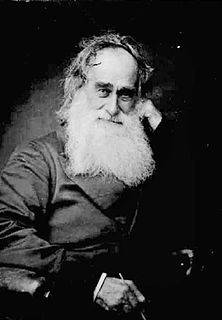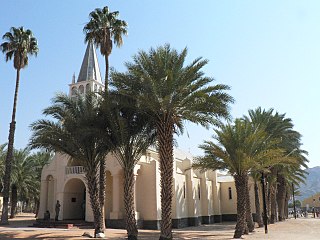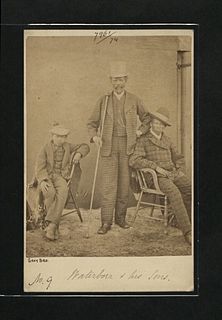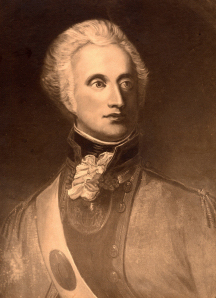
The history of the Cape Colony from 1806 to 1870 spans the period of the history of the Cape Colony during the Cape Frontier Wars, which lasted from 1811 to 1858. The wars were fought between the European colonists and the native Xhosa who, having acquired firearms, rebelled against continuing European rule.

Griqualand West is an area of central South Africa with an area of 40,000 km² that now forms part of the Northern Cape Province. It was inhabited by the Griqua people - a semi-nomadic, Afrikaans-speaking nation of mixed-race origin, who established several states outside the expanding frontier of the Cape Colony. It was also inhabited by the pre-existing Tswana and Khoisan peoples.

Philippolis is a small town in the Free State province of South Africa. The writer and intellectual Sir Laurens van der Post was born here. It is regarded as one of the first colonial period settlements in the Free State.

Campbell is a small town situated on the edge of the Ghaap Plateau in the Northern Cape province of South Africa. It is located 48 km east of Griquatown. It was originally known as Knovel Valley and then Groote Fontein, but was renamed in honour of the Reverend John Campbell who visited the Cape Colony in 1813.

Griekwastad is a country town in South Africa. It is sometimes still called Griquatown, a name which is now considered historical. The town is in the Northern Cape Province of South Africa 168 kilometres (104 mi) by road west from the city of Kimberley. It was the first town to be established in the country north of the Orange River.

Robert Moffat was a Scottish Congregationalist missionary to Africa, father-in-law of David Livingstone, and first translator of the Bible into Setswana.
The Oorlam or Orlam people are a subtribe of the Nama people, largely assimilated after their migration from the Cape Colony to Namaqualand and Damaraland.
The Khoikhoi–Dutch Wars were a series of conflicts that took place in the last half of the 17th century in what was known then as the Cape of Good Hope, in the area of present-day Cape Town, South Africa, between Dutch settlers who came from the Netherlands and the local African people, the indigenous Khoikhoi, who had lived in that part of the world for millennia.

Dr Johannes Theodorus van der Kemp was a military officer, doctor and philosopher who became a missionary in South Africa.
Richard Miles was a Motswana (Tswana) catechist and preacher "to the native tribes beyond the border" in South Africa.

Pacaltsdorp is a suburb of George, Western Cape. In the Apartheid era, it was the coloured township associated with George but administrated independently. The N2 highway provided the natural boundary between the two, enforced by a curfew.

The Asbestos Mountains is a range of hills in the Northern Cape province of South Africa, stretching south-southwest from Kuruman, where the range is known as the Kuruman Hills, to Prieska. It passes Boetsap, Danielskuil, Lime Acres, Douglas and Griekwastad. The range lies about 150 km west of Kimberley and rises from the Ghaap Plateau.

John Campbell, was a Scottish missionary and traveller.

Pella is an oasis in Namakwa (Bushmanland) in the Northern Cape province of South Africa. Earlier known as Cammas Fonteyn, the spring was used by a nearby stronghold of San people. In 1776 a South African Dutch farmer called Coenraad Feijt settled there and lived in harmony with the San despite their fondness for raiding the cattle of the Dutch farmers in the Hantam. A nearby farm called Aggeneys later became the site of the modern mining town of that name.

Nic(h)olaas Waterboer was a leader ("Kaptijn") of the Griqua people.
John Mackenzie was a Scottish Christian missionary who worked in Southern Africa, and who argued for the rights of the native Africans.
Burchell’s Shelter is a small rock overhang and archaeological site located in a kloof in the Ghaap Escarpment at Campbell in the Northern Cape, South Africa. As an archaeological site it has a shallow deposit containing late Holocene, mainly nineteenth century remains. Further interest in the shelter derives from the existence of an eyewitness description by the traveller William Burchell of the last Stone Age hunter-gatherers who inhabited the shelter. Hence it presented an opportunity, recognised by archaeologist Anthony Humphreys, to examine the occupation of the shelter from both an historical and an archaeological point of view.

The Griqua coinage was the first community coinage in South Africa and was introduced by the London Missionary Society.

























